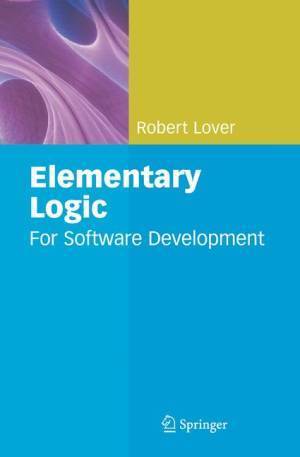
ISBN: 978-1-84800-081-0
Link to Springer
The purpose of this book is to help software developers make better quality longer lasting software by learning more about using elementary logic to communicate about software, to reduce, detect, and remove software errors, to simplify software, to verify correctness of programs, and to read software development literature that presumes knowledge of elementary logic.
Its primary audiences are working software developers and students in any area of computing. No previous knowledge of logic is assumed. Some knowledge of software development is assumed. Since pseudocode is used for programming examples, no knowledge of any particular programming language is needed.
Applications of logic to software development are emphasized throughout. Numerous examples and solved exercises help make the book suitable for self study and for use in college level courses. Its content has been tested in classes and by independent readers.
Click here for detailed contents.
Click here to report errors in book
- Ch01 Atomic Statements
- Ch02 Compound Statements
- Ch03 Quantified Statements
- Ch04 Expressing Arguments
- Ch05 Defining Data Structures
- Ch06 Expressing Problem Specifications
- Ch07 Expressing Program Designs
- Ch08 Truth for Statements with At Most One Connective
- Ch09 Truth for Statements with Multiple Connectives
- Ch10 Tracing Program Execution
- Ch11 Truth Functional Forms
- Ch12 Truth Functional Properties of Program Designs
- Ch13 Quantified Forms
- Ch14 Logical Equivalence
- Ch15 Logical Implication and Validity
- Ch16 Rules of Inference
- Ch17 Proof
- Ch18 Algorithmic Unsolvability Proofs
- Ch19 Program Correctness Proofs
- Ch20 Above and Beyond This Book
Preface
Part I Language and Logical form
Part II Material Truth
Part III Logical Truth
Solutions to Selected Exercises
Sources and Bibliography
Index
- Express and clarify problem specifications, data structure definitions, and program designs,
- Find and eliminate vagueness, ambiguity, and other defects in problem specifications,
- Translate algorithms expressed in English into pseudocode, and
- Understand software development literature that presumes knowledge of logic notation.
- Understand the effect of short cut evaluation of "and" and "or" in programs,
- Calculate and use bitwise extensions of "not", "and", "or", and "xor" to make masks and simple codes,
- Trace execution of programs forwards and backwards,
- Translate program designs expressed in English into equivalent program designs expressed as decision tables,
- Simplify decision tables,
- Analyze program designs expressed as decision tables for consistency, completeness, and redundancy.
- Test problem specifications for logical equivalence and implication, and
- Reduce redundancy in specifications.